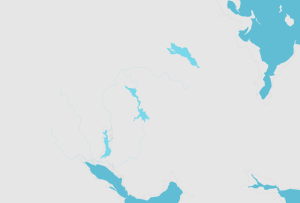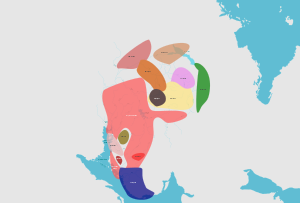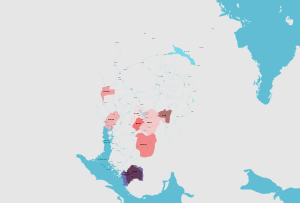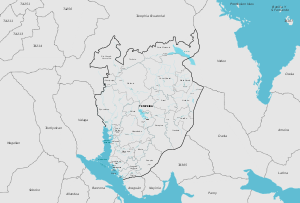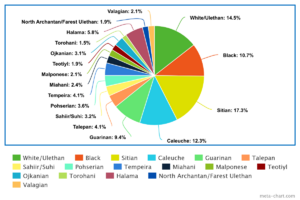Tempeira

|
Most Serene Federalist Republic of Tempeira Tempeira (Tempeiran Florescentian, Tempeiran Sign Language, Kcytiane, Caleuchean (Minority), Guarinán (Minority)) Capital: Mar Agosto ;Tiléia
Population: 121,022,434 (2017) Motto: Nós somos Tempeira, Tempeira é Diversidade Anthem: A Canção dos Pássaros Sagrados |
Loading map... |
Tempeira, officially the Sereníssima República Federalista de Tempeira (Ingerish - Most Serene Federalist Republic of Tempeira), is a constitutional democratic federalist republic in Central Tarephia. It has two capitals, Mar Agosto and Tiléia, its largest city being Carotaba. It borders Barzona, Valaga, Tarephia Equatorial, Vodeo, Dania, TA305, Nayina and Araguán.
Throught it's history the region has been fractured in multiple polities that shared no common culture, however, this does not mean they haven't shared a common history.
Etymology
Tempeira has its etymology rooted in the Sitian word Tanenpere, which translates to "Place of All People", while Tempeira also refered to spices found in the region, the original colonial maps marked the region as Taneperia.
Tempeira was in between 1600-1890 considered to be ooted in the spice trade that ocurred in the region, with the Florescentian name "Colônia de Tempeiros" (Spice Colony - Ingreash), being considered the origin of the name of the country. Only after the Revivalist-Indigenous Movement of 1890 was the name correctly associated with it's origin word of Tanenpere, in Sitian (Place of Peoples - Ingreash). The word appears as Taneperia in old colonial maps as naming the region around the Sitian Kingdoms.
History
Ancient History
Paleolithic
The archeological evidence provided by researches at the Royal University of Corico show that prior to the Middle Paleolithic, there is no sign of hominin habitation, neither homo sapiens or other homo species seemed to live here. The Middle Paleolithic was marked in the region by a low density of sites, most probably caused by the lack of cave systems which would have made sheltering harder, most archeological sites from that time concentrate in the Vodean border regions. Around 40,000 BP, the first signs of human habitation are found in the Guixma Paleolithic Area in the Tempeiran Central Sitian Valley, making the beginning of a long string on influxes to the valley. Their lifes were nomadic, and their diet consisted in animals found in the plains of the region, however, due to a lack of caves and coverage of vegetation during the era, caused by a colder climate, their non-permanent habitations were more similar to the ones found the in the nothern and southern polar and subpolar regions. There is evidence of controled fires by the nomadic people in the Guixma Valley whenever they would leave their old place of habitation, the reasons are still unclear.
The coastal plains were also inhabited, however, more sparcly, the sandy, windswept terrains of the time were hard to live in, and the lack of food sources made for an uninviting location. Though areas that would later become deserts around the world, including northern Tarephia, had seen incredible wet periods during the time, Tempeira was marked by, savannah like biomes with the occasional tropical forest.
Last Glacial Maximum
During the Last Glacial Age, the continental shelf in Tempeira exposed the shallow seas between the modern coast and the island chains located close to it. The Pasem Sea was a wet grassland biome, with the Tarephian Scar forming the Baiosa Takta fresh water lake on it. The lands then exposed have been called of Issulania by Tempeiran researches.
During that time, there was a heavy habitation of whats now the coast of Valaga-Barzona, in the Issulanian Coast, since there was a delta that combined the waters of the Sitian, Bujon and Yoltinemiliziatoya rivers, the Harinian Mega Delta, which was a perfect habitat for a plethera of bird, fish and small mammal species. Most archeological evidence has been lost due to the flooding of the region, however, many artifacts have been found on the shallower areas of the sea.
The region suffered a quick sea level rise, caused by the defrosting of ice caps on the Central Tarephian Mountain Chain Complex. The water released by the ice caused major megafloods and change in local hidrology, it also tore through the Baiosa Takta Lake and opened a gap in the Issulan Izulas Chain.
Mesolithic
During the mesolithic a slow process of a rise in population took place in the Central Sitian Valley, mostly caused by the wetter climate that followed the Glacial Maximum.
Coastal Mesolithic Tempeira saw the apperance and extintion of the Talesasians, between 12,000 BP. to 11,500 BP., that based mostly on the consuption of shellfish and cruteceans.
Neolithic
During this period agriculture started being introduced by Northern Tarephians, in which Sitians came together with other cultures, all forming the Anninan Farmers. The most important region at the time were the Sitian Valley and Delta, the Bujon River Valley and the Talepan Wetland Region, all capable of holding immense agricultural yields.
The Neolithic brought the sendentarism of most of the Sitian Cultures around 10,000 BP and the Coastal Region in 9,500-9,000 BP. The creation of settlements created a better ground for trading routes and innovation, the commoners life was more secure, with cities in certain regions with walls and mudbrick houses. The Sitian Valley at that point separated in 3 cultures: The Early Craton Mound Culture, Upper Sitian Culture and Tropical Sitian Culture. The Sitian Cultures dominated the fertile Sitian and Che River Valleys during the Neolithic.
The origin of Sitians is confusing, their future language and writing is closer in relation to Northern Tarephia and places like Ta-Seti than the Budrians, this has lead many researches to believe that Sitians might be related to the same people who would later rule Athya. However, heir point of origin is still unknown, although some historians and archeologists point to the Sitians being part of the ancient people that lived in the Helion Desert during its last Green Period.
The Costal Cultures with their small canoes started to specialize in fishing on the many lagoons dotting the coast, with inland costal cultures migrating during monsoons to the coast to avoid chronic flash floods and mudslides. During that time, semi-permanent settlements formed on the verge of trading roads, with the most important being Early Guyval, Taramen, A-Aqátia, A-Judialz and A-Trapiches.
Bronze Age
The Neolithic period was marked in Tempeira by permanent or semi-permanent settlements that would shift locations during decades (this does not include the Craton site), the end of Neolitic in Tempeira is marked by the Craton Stone found in the Carotaba region, a inscripted stone with the description of the location of Craton with a small map of the region, dated to 6,500 BP.
The Craton Site is a anomaly on the Bronze Age record, while the entire Sitian Valley started urbanizing and the Early Craton Mound Culture ended, Craton kept a mound tradition on the floodplains of the Paranumbu Lake, the Craton Site has been the longest inhabited settlement on the region, with periods of abandoment followed by new inhabitants, which puzzles archeologists on what was the reason for the repeated resettlement of the site without the apparent alteration of the Mounds and the Great Tell of Craton.
The Bronze Age brought forth the Kcytiane-Annen, Massenans, Itanians, Cito-Annen and Ushians, all related to the greater Sitian Cultural Sphere, while Helenans were Sitianized. The Sitians went through a period of linguistical and ethnical expansion, with the control of major trade routes around the Lycene and the founding of colonies far from the metropolitan center of the Sitian Kingdoms, Cratón served an important role as a religious and geographical center of the Sitian world.
Sitians seem to have loose relations to North Tarephian genetic groups of the Neolithic, however, there is also a mixture of other genetic groups that have yet to be identified, suggesting that Sitians migrated south during the early Neolithic and replaced indigenous tempeiran populations, the Sitian Genetic Group would dominated the upper lyc region until the arrival of the Archantan Sea People.
The Sitian Empire was the main power of the Lyc during the period, followed by the Old Budranians in the southern Lyc, Sitians have been known to have communicated with the ancient Athyan Empie, evidence being found in the Ghary Letters in the Helion Desert showed a extensive trading route from Sitia, north to Athya and east to the Vodean Coast, connecting the Lyc to areas as far as Suvuma. The letters mention the city of Athya by an emmisery of the Tulig Dinasty of Sitia in Athya..
"The gifts from Agu (assumed to be a place in the Lower Sitian River) have been well received by ------------------------- (this part of the letter has been lost) ------------------------, on the contrary Ssia (pressumed to be the name for Athya) seems to prosper, I would request a brief return to my homeland at The CYT (Sitian) River, to participate in the festivals this moon cycle, however, Athya is too far for my arrival in time, I will however use their river to prestige my Goddes Týh*, may her guidance take my offerings to the infinite blue."
The letter is somewhat confusing, as it mentions a river in the Athyan lands, though archeological evidence shows that Athya did rule over both Gharbiya and Ta Seti, the period this letter is dated to seems to align with the period in which Ta Seti was already a independent entity, that even was in constant war with Athya, so the mention of a river indicates that the old Athyan capital sat somewhere in the dry river valleys of Gharbiya.
The Sitian Empire lasted from around 4,500 BP to 2.900 BP, in it's height, it ruled over all of the Sitian River and major tributaries. The Paranumbu Lake (Ilopé Lake at the time) was the mos important asset of the empire, the navigability of the Sitian up to the lake allowed for direct trade of inner region with the coast with no need for treversing the Recca Mountains. The empire provided mainly grains and Tin to the rest of the trading routes, most of which ended in the Lycene.
Sitia as an empire was unique in its orginization, being closer in relation to hellenian city-states than a proper empire. Each metropolis of the empire held its own king or preffered ruler, but with a centralized government that would run the military and agricultural output, this in turn, made cities in the Sitian Valley at the period less flaunty and with lower urban organization than other regions at the time.
Bronze Age Collapse
The Bronze age collapse was a extensive process of the de-urbinization of early civilizaions and loss of technology and knowledge due to the collapse of organized society, historians argue in what might have been the main reasons to the collapse but with no consensus, the most accepted reasons are:
- Overpopulation pressure collapsing system of government and economy;
- Lack of knowlegde of erosion and climate change due to agriculture causing a collapse on the food chain supply;
- A natural period of warming climate post glacial age enlarging the reaches of deserts around the world and lowering water supplies in certain regions;
- Oversupply of Ironwoks that collapsed the economy;
- Changes in battle tactics that led to bigger scales in destructions;
- Mass Migration related to climate.
In Sitia the climate and economy were favorable, though a drier climate period came, it helped diversify certain crops. The most agreed reason for the Sitian Empire's collapse was the introduction of a more centralized government and a isolation period caused by the loss of trading routes.The crentalized government started introducing policies such as mass migration and over cultivation of the land as a form to preserve internal stability, but internal focus made the empire's borders weak, and caused the collapse of multiple polities on the frontiers of the empire, later leading to the fracture of the Sitians into multiple kingdoms, around 2,900 BP.
However the biggest loss was the interruption of trading routes, specially with Ta Seti, records show that around the collapsing age, Ta Seti stopped trading with Sitia, which was considered a lost country for millenia in scholar circles in Uletha. The collapse of the economy was the driving factor for the collapse of society in the region, surpassing issues caused by governence or even climate.
The Sitian downfall and loss of influence on the region was followed by a migration have across the ocean that would bring the Archantan Sea People. Most of the coastal and navigable regions became partly or fully influenced by them, specially in the Lycene.
Caleuche and Guarinán both descend from a multitude of people crossing the sea, with Caleuche eventually settling down around the mouth of the Sitian River. While Guarináns migrated from Lower Fojenica a few hundred years later.
Caleuche Empire and Ceuci-Quaraí
Around 2000 years ago, after the arrival of the Sea People, the local polities started to concentrate power in certain cities, like Coricó, Old Ceuci, Acól and Talepó. The Caleuche, from Coricó, through many alliances were able to conquer the eastern coast of the Marrino Estuary and the Sitian Delta, slowly expanding south as far as Port Catâmia and controlling for a long time the trade in the region.
The process of Calephication (assimilating other people into the Caleuche culture), was concentrated in the northern coast of Tempeira. Other people in "Valaga" and Barzona would constantly be raided by Caleuche navy and later pirates. The Caleuche culture at the time revolved around the worshipping of earth deities and ancestral spirits, and had a strong belief of the Triple Sword Philosophy (always looking into the past, present and future), that even influenced the urbanism of their capital (with the Triple Eagle Plan).
The Caleuche were in constant conflict with Sitians and Talepans, and most territories south of Tantantan were constantly exchanging hands, however, in the region of Ilheus, the Caleuche colonists were able to stablish a piracy-based state that even raided Caleuche settlements as far as Co-Cuíen. The Caleuche Emperor Jaích Muchu was even captured by pirates, and common folklore tells of how the Emperor was such a calming presence that it made the pirates rethink his capture and their ransom, and left the Emperor back on the capital. However, this didn't stop pirates of raiding the capital island a few years later, forcing the Emperor to spend time and resources to pacify the islands, a trend that continued with other emperors, and in turn it weakened the borders of the Caleuche.
The Ceuci started as a group of city-states around 1,500 BP. to 1,050 BP. in a region of the Ceuci River watershed more isolated from the coast, many cities were built on Tells and continue to be. Around 900 BP. to 90 BP. a series of inovations on agriculture on the guarinán culture allowed for a greater expansion of cities' power over the region. Eventually during the Ceuci Golden Era in 200 A.P. Ceuci came to dominate the local economy and slowly annexed neighbouring cities unil the formation of the Ceuci-Quaraí Empire in 430 A.P.
Ceuci was very influential on the regions of Arasí up to Kuran, Torahan and even parts of Vodeo. However their location made it for a difficult spot for maintining control over large regions, eventually places like Arasí were re-colonized by Sitians and a mixture of Sitian and Guarinán elites came to rule independently of Ceuci.
Rivagiens
Rivagiens arrived around 1240 around the region of the Tamatan Culice (later the Tantantan Province). Caleuche, was not surprised by ulethans, though no direct contact had been made before, trading between Uletha and the Lycene was already established, with Budranian goods being found as north as Plevia. The Caleuche representative in Tamatan, Alepi Aty, reportedly communicated directly with the RIvagiens Armada and welcomed them inside the royal palace, however, in the years after, the Emperor of the Caleuche Xuaty Myci II, gained distruss with the Valonian colonists, their fame as a violent power in the region grew rapidly and Caleuche, together with other powers in the Sack of Oridica were slowly entering discussions of what to do.
The Talepo city-states at the coastal regions were eventually absorbed by the Rivagiens Empire, the eventual fall of the Empire would bring the collapse of most of the remaining Talepan city-states.
Tamatan would become the only official trading post between the two empires, while Valonian pirates would sometimes enter the archipelago region for sacking, they were generally against venturing so much into uncharted territory. At the time for example, there was no Ulethan knowlegde on the deltas located at the ends of the Sack of Oridica, it was believed that the sea carved its way onto the western tarephian coast through the rivers located there, is believed that the lakes located in central tarephia were mistaken for the southern lycene seas.
Florescentian Arrival
Florescenta, wanting to expand its territory, aimed to carve out small pieces of land through out the tarephian region. In 1350, Florescenta lands on Estreito, close to Port Catamia/Montblanc, founding the Nossa Terra Sagrada de Nova Florescenta (Ingerish - Our Sacred Land of New Florescenta).
Florescenta soon founded the town of Atalaia dos Fortes, in between the small Mata Lake and the Capivara Lake, it was easier to access the mainland and it had a good natural harbour. However, the marshy, loose soil would soon be eroded away in a cyclone, called The Storm of Saint Rita, most of the city was flooded and sank bellow sea level, Florescenta almost gave up on colonization efforts, however, the cyclone helped erode the sedimented regions around Montblanc, allowing for more ships to anchor in its harbour.
During the next 50 to 70 years, the Florescentians move up the coast founding cities, until they stumble upon the Bay of Fire, currently Mar Agosto. There they founded Vila Maria Antunes in 1400, it was destroyed in 1410 by Caleuche Pirates that lived mostly around the bay area, Florescenta invaded the pirate islands and subjugates them for the time being, however this attack infuriated the Caleuche Emperor, that used the pirates as a means to control the lower tempeiran coastal trade. Maer A'gosto is founded in 1422 in the ruins of Maria Antunes.
The Colonial Wars
In 1470 the multiple colonies under Tempeira are joined into the Afluentes Florescenta Colony, the ulethan power had long been trying to annex the rich coastal towns to force the interior regions to collaborate, however both Sitia and Caleuche had won multiple naval battles against Florescenta, with the centralization of colonization efforts, naval forces were more easily moved around the Oridica Sack.
In 1478, the Florescentians give an ultimatum for Tantantan, to open its port for ulethan ships, or be captured. This was the final straw for the Caleuche, who declared war against Florescenta. During this brief war, the Valonian minority inside of Tantantan revolted, and helped ulethan forces to capture the city and surrounding regions in 1480 in a coup. For a brief period of time, between 1480-1495, Caleuche and Florescentians would have small battles along the new border, but in 1495, the Machacol Treaty is signed, allowing bigger trading between the two and acess inside caleuche cities. This would mark the end of the 1st Colonial War and the beginning of the end for the Caleuche Empire.
The Caleuche were able to marry with a few lower tier nobles of Florescenta, this would initially help Caleuchia to keep its independence, however, during the sucession crisis of 1525, a group of mixed nobles threw a coup that killed the sucessor of the late Emperor Malon Myci, putting Huandro Jacquan in power, the crisis caused a civil war inside Caleuchia that spilled over to Tempeira. The Florescentian Crown decide to step in, and together with the Ingreans, invaded multiple coastal towns, Coricó was invaded in 1540. With the fall of Coricó, the Caleuche Empire was absorbed by Tempeira. In the treaty signed the year later, Caleuche was recognised as a protectorate of Florescenta, with Restinga being its seat of power.
Colonial Period
After access to the sea was finally cut with the fall of Caleuchia, Sitians and Ceucis were faced withthe fact that Florescenta was not aiming for taxation of ships, but to cut the regional powers from the rest of the world, weaking morale of sitians would help Afluentes to slowly annex territories in the southern sitian borders, including the Sitian vassal Talepan city-states. In 1570, Florescentia had a major win after capturing and destroying Latonia (Latomnia), a rich gold mining region and city.
Sitians were not used to ulethan techniques of war, however a Sitians were able to hold more ground than expected. Sitian General Tanen Likci developed a plan to wreak havoc inside the colony, the Freedom Plans. The Freedom Plans were made up of various sitian militias infiltrating big slave plantation and cities and freeing them and creating a civil war distracting enough so that northern caleuche cities would be able to be re-conquered, however, the plan backfired, in 1882, in Porto Catâmia, a group of 1,220 Sitian Militia Personel invaded the plantation around the city and mansions and freed thousands of slaves, but instead of a great fight, slaves started to run away from the city, and the Militia had no other chance then to retreat with the slaves. The refusal to fight angered the sitians, that demanded the expulsion of the now freed slaves from sitian lands, the king ordered that the freed people were to be moved beyond the Kudan Desert, around were Cajueiros sits nowdays.
Epucaleuche Republic
The Epucaleuche Republic lasted from 1759-1809, Florescentans were able to push for Tileia and Corico, caputilating the state, in the Sacrament Treaty following the end of the war, many major cities of the empire received sectors of florescentans, many areas are still called Sacrament Accord. Cajueiros however, remained independent, many attempts in conquering the region were made but failed.
Transloudrinian Wars
During the early 1800's, Florescenta and Ingrea had an issue, no defined border was marked in between their territories. Loudrinia as it was called was a territory unclaimed by both parts because of its hard access, this made for a perfect spot for people looking to escape colonial rule to hide in.
In 1802, Gold was found in the region of Loudrinia, starting the Transloudrinian Gold Rush, both powers wanted control of the gold mines, specially Florescenta who was in a stalling war against Epucaleuche. Loudrinia was a semi-independent state of Vodeo de facto, however, 85% of the population was either florescentian or indigenous, this created an unique cultural region.
The peace between people was quickly ended when outside governments started influencing internal politics. Quickly, Transloudrinia entered a Civil War between Florescentian and Ingreash speaking colonists, sparking a conflict that both Florescenta and Ingrea decided to intervene, in hopes of not only controlling the gold influx for their colonies, but also annexing the limbo state.
Epucaleuche on the other hand, seized this opportunity to declare war on Vodeo to try and annex more of it's "lost territory". The Transloudrian War is also called the 4-Sided-War. Eventually Florescenta and Ingrea, realizing the stalling of the conflict, decided to divided the teritory along linguistical lines. While Epucaleuche, during that time lost and was annexed to the Tempeira Colony, in 1810, the Loudrinian Agreement is signed in Silverton.

Republican Dreams
Scholars from the Epucaleuche Republic moved into Florescenta and its colonies after the annexation, mixed with illuminists, this created a big movement for republicanism, specially in Tempeira, where the colonial control was becoming even more draconian than before.. Many florescentans at the time were tired of the constant infighting between the aristrocracy and constant war with neighbours, and so a growing movement of republicism took power of colonial governments. In response the central authority banned local governments in 1815.
Union Revolts
In response of the banning of localized governments, many port cities decide to revolt. In 1826 port workers secretly threw gunpowder into cargo holds of Naval Ships in Maer A'gosto, in a secret cabal with lower rank marine officers, many of this ships were set ablaze and eventually exploded, damaging most of Maer's port, republicans declared the Justine Republic as a provisory government in Maer, but claiming all coastal colonies. In 1828 Maer is regained by Florescenta and in response the Florescentans introduce a plan to better control the colonies bu create a sense of more autonomy. A group of lower rank nobles was given the opportunity to become part of the new Duchy of Tempeira.
Independence
In 1835, in response to the Duchy, another independence movement, powered by the reintroduction of slavery and serfdom, takes control of most of the nation, with only a few islands and major cities in hold of florescentian power. Republican Troops move south to Araguán to control the strait region around Comodoro de Peña, this quickstarts the Araguanese Independence movement, that joins Tempeira and fully takes control of the colony in 1840. In 1841, after all main mainland holds were lost, Florescenta gives up in defending the colony. In 1844, the Treaty of the Republic is signed, and Tempeira is fully independent.
Araguán
In 1850, the mainly castellanese speaking population of Araguan, then called Great Cualca, declared independence from Tempeira, the latter, in a weak economic state, has no choice than to accept the independence. In 1967, during the brief military coup, the northern half of Araguán was invaded and the parts of the population were forcibly moved, in 1970, after the fall of the militaristic government, most of Araguán is given back, however, the northern tip of the country is kept, on he basis of population.
In 1980, the Talepan Unification Movement (TUM) is formed, with the objective of joining all of the greater territories of the Talepan culture together, TUM became a para-military group that has loose associations with many politicans in both Araguán and Catamian Araguán, during the 1990's the group made a series of attacks on govermental building in both the state and country, though crackdowns were able to stop the terrorist attacks, the group remains active.
Geography
Topography
People
Located in the crossroads of multiple cultural regions, the northern Lyc has been the stage of multiple migration periods, including the expansion of the Imani Caliphates. The country is diversed, but sometimes heavly segregated, for example, 87% of the more than 10 million Caleuche live in the State of Caleuxé, while most Sitians live in the Sitian and Che valleys.
During independence this almagomation of multiple cultures was used to justify the union of the nation, while many wanted independence for their own people, the fact that fragmenting the larger state in minor ones would weaken once again their border was enough to convince the local elites to give power away to a more centralize authority, eventually, with internal migrant movements, the once clear ethnic borders became more closely tied to community-to-community interaction, meaning that inside of a small region you could have multiple villages that did not share cultural ties to eachother.
However, the Tempeiran government, early in its days divided the country by ethnic-states. This would fuel clashes for land expansion.
Early in this process, race wars were common, specially between the larger ethnicites and smaller ones, the most know being Sitians vs Pohserian or Guarinan vs Torohani. With centralization becoming more common, multiple elite classes fought over the right to hold have the capital in their territory. This culminated in the Reigning Wars of 1820, in which the major old capitals (Talepo, Ceuci, Arasy, Ruda, Acol, Corico and Porto Catamia) fought over the control of the Union. The war ended in 1827, after Sitians and Ulethan settlers reached a stalemate between themselves and other cities had lost mos of the control over their own territories, the Treaty of the Union signed after the war created two capitals (one for settlers and other for the indigenous cultures), one was the transfer of the Ulethan Capital to Mar Agosto and the creation of Tileia, against the wishes of both Caleuche and Ceuci, who claimed that building a new capial next to the old Sitian Capital would consolidate power in the hands of the Sitians, to appease these concerns, Ceuci and Corico were given more relaxed taxation and their territories were expanded (however the territories would be divided once again in the 1960 Constitution).
The Tempeiran National Data Institute (TNDI or ITND) divides the multiple tempeiran ethnical groups in 4 different categories:
Tempeiran - People with multiple ethnical backrounds or anteraphians that were born in Tempeira (Tempeiran, Black)
Sitians - This includes all groups under the Greater Sitian Cultural Sphere (Sitians, Talepan, Miahani, Malponese, Halama)
Ulethan/Post-Colonial People - Generally includes all groups that have migrated willingly to Tempeira (White/Ulethan, North Archantan/Farest Ulethan)
Pre-Colonial People - Associated groups of indigenous people out of the Sitian Sphere of Influence (Sahiir/Suhi, Caleuche, Guarinan, Pohserian, Teotiyl, Ojkanian, Valagian)
Culture
Education
States
Major Cities
Mar Agosto
Carotaba
Tiléia
Ceuci
Porto Catâmia
